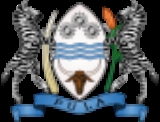
Coat of arms of Botswana
Encyclopedia
The coat of arms of Botswana
was adopted on January 25, 1966. The centre shield is supported by two zebra
s. The shape of the shield is that of traditional shields found in East Africa
. On the top portion of the shield are three cogwheels that represent industry
.
The three waves symbolize water, and reminds the viewer of the motto
of the nation: pula, which means simply "rain", but also good luck, and is the name of the nation's currency
. This motto also highlights the importance of water to Botswana. The motto is found at the bottom of the coat of arms on a blue banner.
At the bottom of the shield is the head of a bull, which symbolizes the importance of cattle herding to Botswana. The two zebras are present since zebras are an important part of Botswana's wildlife. The zebra on the right holds an ear of sorghum
, an important crop in the nation. The zebra on the left holds a tusk of ivory
, symbolic of the former ivory trade
in Botswana.
Botswana
Botswana, officially the Republic of Botswana , is a landlocked country located in Southern Africa. The citizens are referred to as "Batswana" . Formerly the British protectorate of Bechuanaland, Botswana adopted its new name after becoming independent within the Commonwealth on 30 September 1966...
was adopted on January 25, 1966. The centre shield is supported by two zebra
Zebra
Zebras are several species of African equids united by their distinctive black and white stripes. Their stripes come in different patterns unique to each individual. They are generally social animals that live in small harems to large herds...
s. The shape of the shield is that of traditional shields found in East Africa
Africa
Africa is the world's second largest and second most populous continent, after Asia. At about 30.2 million km² including adjacent islands, it covers 6% of the Earth's total surface area and 20.4% of the total land area...
. On the top portion of the shield are three cogwheels that represent industry
Industry
Industry refers to the production of an economic good or service within an economy.-Industrial sectors:There are four key industrial economic sectors: the primary sector, largely raw material extraction industries such as mining and farming; the secondary sector, involving refining, construction,...
.
The three waves symbolize water, and reminds the viewer of the motto
Motto
A motto is a phrase meant to formally summarize the general motivation or intention of a social group or organization. A motto may be in any language, but Latin is the most used. The local language is usual in the mottoes of governments...
of the nation: pula, which means simply "rain", but also good luck, and is the name of the nation's currency
Botswana pula
The pula is the currency of Botswana. It has the ISO 4217 code BWP and is subdivided into 100 thebe. Pula literally means "rain" in Setswana, because rain is very scarce in Botswana - home to much of the Kalahari Desert - and therefore valuable. Pula also means "blessing" as rain is considered a...
. This motto also highlights the importance of water to Botswana. The motto is found at the bottom of the coat of arms on a blue banner.
At the bottom of the shield is the head of a bull, which symbolizes the importance of cattle herding to Botswana. The two zebras are present since zebras are an important part of Botswana's wildlife. The zebra on the right holds an ear of sorghum
Sorghum
Sorghum is a genus of numerous species of grasses, one of which is raised for grain and many of which are used as fodder plants either cultivated or as part of pasture. The plants are cultivated in warmer climates worldwide. Species are native to tropical and subtropical regions of all continents...
, an important crop in the nation. The zebra on the left holds a tusk of ivory
Ivory
Ivory is a term for dentine, which constitutes the bulk of the teeth and tusks of animals, when used as a material for art or manufacturing. Ivory has been important since ancient times for making a range of items, from ivory carvings to false teeth, fans, dominoes, joint tubes, piano keys and...
, symbolic of the former ivory trade
Ivory trade
The ivory trade is the commercial, often illegal trade in the ivory tusks of the hippopotamus, walrus, narwhal, mammoth, and most commonly, Asian and African elephants....
in Botswana.

